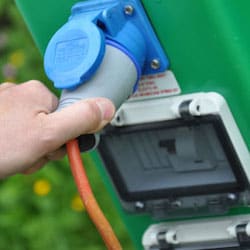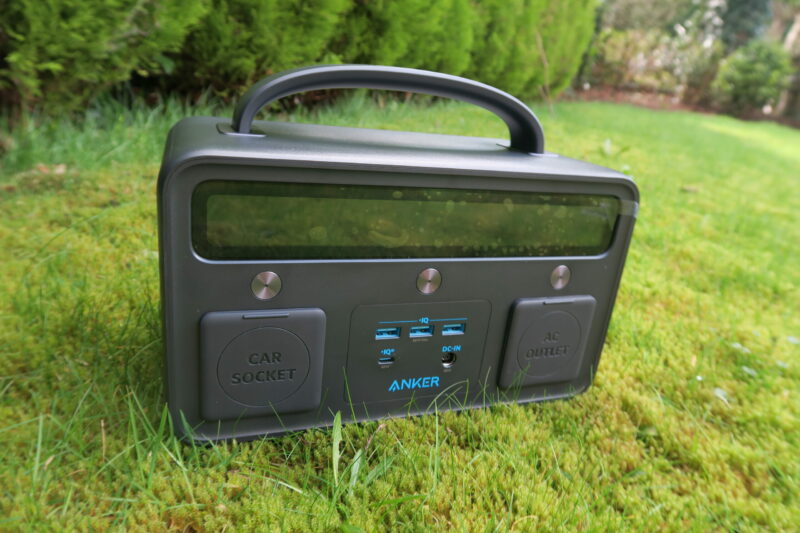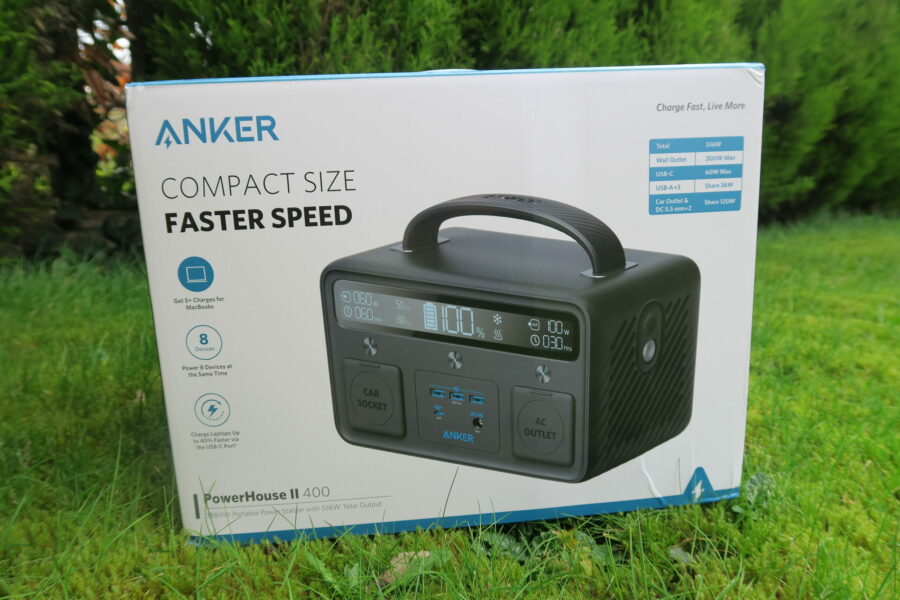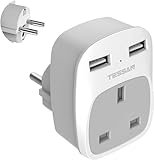Some of the questions we get the most are about camping power…how do I charge my laptop, power my camping fridge or use an electric hob when camping?
We’ve looked at the options and compiled our findings for you. We’ve tried to keep things simple and untechnical, with tried and tested recommendations for hook-up, portable powerbanks and solar power. Read on…
All our reviews at Campfire Magazine are independent and honest.

In a hurry? If you don’t have much time using the links below to quickly find our favourites for you. You can be assured we only choose the best products…
Campsite power – EHU hook-up
If you’re on a campsite in a campervan or caravan, then electric hook-up is the easiest answer. You’ll pay a bit more for your pitch, but the convenience of being able to run everything from your fridge to your hairdryer is usually worth the extra.
Using a hook-up cable
To use the site’s electric points, you simply need to attach a cable. The cheapest of these will be a single cable with a connector for the site’s electric point at one end and a connector for your campervan at the other. Easy! Your own decision will be what length to go for – they vary from around 5m to 25m. Prices from start from very little.
This type of cable connection links to your vehicle’s internal electrics so you can use your built-in appliances and power-points.
Hook-up for tents and van campers
If you don’t have an electric socket on the side of your van, or if you’re in a tent, you can still hook up to the site’s electricity. All you need is an extension reel with the right socket connector on one end. The best of these we’ve found (and used) is the Crusader PowerPro.
It’s a box of tricks with three 13amp plug sockets, three USB slots for charging phones and laptops, a detachable LED torch and, of course, a 15m cable with plug for hooking up to site electricity points. There’s also a circuit-breaker and a built-in polarity warning light (see the tips section below). They’re not light at 4.4kg but it’s a lot of kit in a small package.
More EHU hook-ups for campers
There are quite a few camping hook-up alternatives to the PowerPro.
Outwell make a three-socket Mensa hook-up roller (below) with a built-in light. Again, a 15m cable, three sockets, two USB portsand polarity warning. This one rolls into a more conventional looking extension reel and weighs around 4kg. (a cheaper version without USBs and light).
If you don’t mind all that cable messing up your neat packing, there are plenty of simpler options, such as the Crusader mains EHU unit (above).
This black and orange EHU cable is a bit prettier (in our opinion) and has the bonus of two USB slots.
Hook-up tips

Tip 1: Prepare for distance!
We carry two different lengths of EHU hook-up cable – 5m and 20m. If you’re on a pitch close to the electricity point, you can avoid all that cable snaking everywhere by using the shorter one.
Tip 2: Check the polarity
Some sites (more so in Europe) have reversed polarity, where the live and neutral are the wrong way round. It can be a shock hazard, so it’s safest to check it with a plug-in polarity tester (only a fiver). If you find the connections are reversed, then a polarity adaptor sorts it out.
Tip 3. Keep it neat with a cable bag or cable tidy reel.
Tip 4. Know your sockets
Some continental campsites have a different type of socket. If so, you’ll need a cheap continental or euro adaptor. Campsites can often lend or sell you one, but taking your own can pay off.
Power requirements for camping
We spotted this in the shared kitchen of our favourite campsite – Neil and Pat being as helpful as always!
The best way to power your fridge
First of all, have a look at our guide to choosing a fridge. It may be that you don’t need a powered camping fridge at all – there are some very efficient passive coolboxes out there.
If you don’t want to be changing ice packs, however, you’ll either have a 12V coolbox or efficient compressor fridge connected to the car or campervan 12V (socket). The best compressor fridges use very little power and will alert you if your battery is getting low.
Another option is a brilliant car fridge (absorption coolbox), which will work on electricity when you’re at a campsite, 12V when you’re on the move and gas when you have no electricity. These do tend to be big beasts, but they give you a lot of freedom.
More on powering by solar further down the article.
See more of our camping fridge and coolbox recommendations. Another factor around keeping cool is looking for the Best Air Conditioners for your Motorhome lookily we’ve done an article on this too!
Electricity for camp cooking
Most campers tend to cook on gas and that certainly liberates you to cook anywhere. Even more freeing is cooking using a woodburning camping stove.
If you want to use an electric kettle, then you’ll need campsite electricity. We’ve tended to choose smaller, lower wattage models like this one-litre Igenix kettle just in case the campsite can’t cope.
Electricity for cooking, though, can make everything a bit faster. We’ve used a small, portable induction hob, for example. Again, you need a campsite electricity supply and one of the cable options from the section above.
Have a look at our feature on electric cooking options for when you’re on hook-up, including the Remoska, induction hobs and a portable microwave.
Keep phones and tablets charged
Because phones take so little power, the 12V socket in the car or campervan is usually all you’ll need. The same goes for any device that can be USB powered.
When you’re choosing your 12V-USB adaptor, check whether you’ll need USB, USBC or both (like this Tecknet one). Flush-fitting is neater too.
If you’re wild camping or camping without a vehicle, then have a look at the portable power section below.
Laptops, though, draw more power. You can use campsite mains electricity, a high-powered portable battery bank (see next section) or an inverter (if you must).
Keeping medicines cool
The impetus for this article was, in fact, a question we had from a reader wondering how to keep their medications cool while camping in summer.
As well as passive coolers designed for insulin, there are some neat little powered devices. Absolute best of the choices is the LifeInABox portable medicine fridge.
It can hold eight insulin pens or bottles of injectables, has an app for control and runs from a normal power outlet or the 12V in your car or van. Constant temperature and a beautiful object too.
Inverters
We’re not fans of inverters. Basically, these convert the 12V supply from your leisure or car battery to 230V, so you can plug in a laptop or other low wattage device.
The reason we’re not keen is that they actually take power to operate, they can be noisy, it’s too easy to run down your battery and, unless you have a high wattage model (connected directly to the battery), you still won’t be able to plug in an electric kettle or fan heater, for example.
If you’ve successfully used an inverter, let us know. In the meantime, we think they’re not worth the risk when you can stick with 12V charging, cook and boil a kettle on gas or use hook-up.
A 1000W Bestek inverter sounds perfect, eh? If you’re running anything over 150W, though, then it needs to be connected to the battery rather than through the car or van’s 12V socket. Your car needs to be running too.
If you’d like to try an inverter, then you need to carefully work out the peak wattage of the equipment you’d like to run and the length of time it’ll be on for. A laptop, for instance, will need an inverter of at least 150W and, depending on your battery, will run for between five and eight hours before your battery is exhausted
Perfect camping power – portable and versatile
You can buy fantastic high-powered battery banks that will work with 12V and 240V AC equipment (and even connect to solar panels in some cases).
Look for lithium-ion batteries as these can be left charged and won’t run down when they’re not in use. Far more efficient than lead acid batteries.
Poweroak portable power
Pure sine wave portable lithium ion power, chargeable via car, solar or wall socket. A good mid-price compromise. Use with any appliance under 220Wh. Click here for latest price.
- Inputs: Solar, 12V or wall charge
- Outputs: AC 110V-60Hz/300W (Pure sine). USB 5V/4×3.5A(Max). DC 12V 2x3A
- Size: 23 x 14 x 23 cm
- Weight: 5.5kg
Anker Powerhouse II
The Anker power house is a great portable power bank, the side torch feature and ambient light at the back will light up a camper or tent easily is a really good addition, it is super easy to use and has a really clear LED display so you can see what power you have left. We tried this out ourselves and took maybe 4 hours to charge fully and we managed to charge the phone 6 times, the laptop 4 times and the ipad once! A very handy AC socket as well as usb outputs means you can use it for most things and it can handle charging 8 devices at once. It can be charged via solar power too (you have to buy the panels separate). Great compact size, rugged shell, to be honest I think this will be a staple piece of gear for us even when not on site it will charge our phones and the kids tablet while travelling in the car which can save allot of headaches!
- Inputs: DC Input: 11-28V 5.5A (65W Max), USB-C Input: 5V 3A/9V 3A/15V 3A/20V 3A (60W Max), USB-C 60W + 65W DC Input: 125W Max (USB-C Charger not included)
- Outputs: AC (Pure Sine Wave): 110V~ 2.72A, 50Hz / 60Hz, 300W, USB-A: 5V 7.2A (2.4A Max Per Port), USB-C: 5V 3A / 9V 3A /15V 3A / 20V 3A (60W Max), Car Socket + 5.5 mm DC: 12V 10A (120W Max)
- Size: 255 × 148 × 139 mm
- Weight: 4.62kg
Energizer portable power
The cheapest we've found with a suprisingly good range of features. Small enough for backpacking too. Around seven hours to reach full charge.
- Inputs: Solar, 12V or wall charge
- Outputs: AC corrected sine wave output (200W continuous or 320W peak), 4 x USB and DC 9~12.5V/10A (15A max),
- Size: 33 x 25 x 17 cm
- Weight: 2.4kg
Allpowers battery bank
Another affordable option is the Allpowers battery bank. You won’t be able to charge this from the car or van, however.
- Inputs: Solar or wall charge
- Outputs: 12V, USB, USB-C and AC. Pure sine wave
- Size: 20.57 x 16.51 x 10.92 cm
- Weight: 3.4 Kilograms
The best camping lights
LED lights use barely any power, so there are lots of options these days for USB rechargeable camping lights. Add a portable power bank (see below) or recharge from the car’s 12V socket.
Some also come with built-in phone/tablet chargers that work by either solar or, better still, a combination of solar and USB.
Luminaid for light and power
The inflatable 2-in-1 Luminaid, for example, has been tested in disaster situations, so is a good pick. It folds down to virtually nothing, is waterproof and gives up to 50 hours of light (on low) when fully charged. The Luminaid without phone charger is cheaper. Perfect for when you need to take to your camping toilet.
Luci Base Lamp
We quite liked the original inflatable Luci light, but this bigger Base Lamp is really good. Three brightness settings, no weight, waterproof, charge lasts for ages and you can charge your phone with it.
Neat folding light
And for a good light to read or play games by, this folding rechargeable desk lamp is perfect. Four brightness settings and charged by USB.
Pocket-sized light and power
Found under a number of different names, this small lamp has a 4W LED light but is also an 8800mAh power bank too, so you can charge your camera or phone through it. You’ll get around 18 hours at full brightness. Waterproof too. Larger size available as well.
Versatile Luminoodle
Fairy lights and brightness in one, We like the Luminoodle because it’s decorative as a lighting strip you can hang with ties or magnets, and also folds into a bag to work as a table lamp. Bright, rechargeable and can work directly from a USB adaptor in the 12V socket. Comes with or without its own powerbank. We adore this idea, so much so it topped our article about best camping string lights.
Portable camping power
If you’re an explorer rather than a campsite comfort-seeker, then you’ll want a portable power pack to charge your phone, camera or tablet.
The key number is the mAH (milli-ampere hour). You’ll find powerbanks as low as 1,000mAH and as high as 30,000mAH. The higher the number, the more charge you’ll get, but the trade-off is weight and size. Some airlines won’t allow very high-powered battery banks.
For goodness sake, please don’t buy a disposable powerbank – apart from being very low mAH and slow, they’re an environmental menace.
What to look for in a portable charger
Features to look out for are Quick Charge 4.0 and USB-C. If these are useable for input as well as output, they’ll be faster to charge themselves (as well as faster to charge your phone)
Passthrough charging is something to look for too. It means you can charge a phone at the same time as the powerbank itself.
PowerIQ or similar-sounding names tell you that the charger can recognise the type of device you’ve connected so that it can deliver the optimum amount of power.
These are great for phones, tablets, cameras and LED lights, but you’ll need a higher performing battery bank for laptops. Check the wattage of your machine.
If you have a new(ish) MacBook, you’ll need extra oomph from your battery bank. The BatPower P26B will charge a laptop.. For larger laptops (15″ and so on), BatPower has other options too.
You’ll also need a cable (often supplied), as your three-pin plug won’t attach to the bank, unless you go for one of the few powerbanks with an AC socket. See the next bit…
AC-outlet powerbanks
There aren’t many powerbanks with a three-pin socket. This Aisung 31,200mAH 100W powerbank will charge laptops, MacBooks, GoPros, lamps and small fans.
You can power more than one device at a time and it has outlets for a UK plug, USBA and C and micro-USB. Enough power to charge a 12″ Macbook 1.8 times.
Pocket chargers are a valuable tool to have in your kit. On campsites, we’ve seen people leave their phones plugged in to charge in the shower blocks. While honesty is a hallmark of campers, we’ve always worried about the danger of phones getting knocked into sinks or soaking up condensation. Leaving a charging unit to recharge rather than the phone sounds like a good idea.
We’ve tested a few powerbanks that we like and trust
Anker powerbanks are consistently top-rated.
Zendure chargers are simple, neat, fast and tough.
BatPower – some very high-powered options and great reviews.
Fast charging for laptop and phone
As mentioned above, we really like Anker chargers. This Anker dual charger is packable and will charge a Macbook in around two hours. A USB-C port delivers 30W of power to charge phones, tablets, and laptops, while a 12W USB port charges mobile devices.
Now keep it all tidy
You could stuff all those cables and plugs into a BIG pocket, but isn’t this nicer? I’m getting excited about the fun I can have organising and reorganising with this Bagsmart cable bag (I know, I know!)
This Tessan plug adaptor for European sockets has the extra benefit of USB inputs. Very neat.
Tidy cables – Proporta’s simple but effective magnetic clasp for headphones and charger cables. Bye bye tangles. We use them for all sorts of other bits and pieces too.
Solar power for campers
The holy grail of power? We’d probably all like to be able to stick a panel in the sun and power everything easily, quickly and for free. Instead, if you’ve ever started to research solar power for camping, you may well have given up – bamboozled by the maths you have to do.
Whether it’s a permanent installation or a portable solar set-up, the power you get will, of course, be affected by how much cloud cover you get. Most good solar panels won’t need bright sunlight all the time, but won’t perform well in cloud.We turned to a few experts to help us unravel the potential of solar – in particular, thanks to Caroline Rawlinson at Solar Technology International for some much-needed guidance.
Solar panels for campervans
If you’re thinking of getting a larger solar panel fitted into the roof of your campervan, then your installation will, most probably, integrate into your vehicle electrics and power your leisure battery.
Getting that right means finding an installer you trust or speaking to people who’ve done a successful DIY job.
“You need to check with the installer not just about the panel’s capability but about how power will be regulated to avoid damage to the leisure battery,” says Caroline. “This is a fairly simple option for 5V and 12V devices, but if you want to plug in a three-pin 230V appliance (running on AC), you need an inverter. An inverter itself needs power to run, so make sure your installer gives you advice about turning it off when not in use.
“Solar panels can be useful for trickle-charging the battery when the campervan isn’t used very often in storage, for example.”
Just to stress Caroline’s point that solar panels generate DC power. If you want to plug in a three-pin 230V socket, you’ll need to convert to AC, using an inverter.Solar powered camping fridges
As mentioned in the fridge section above, good compressor fridges run efficiently on 12V and only draw power when needed.
If they have good insulation, they won’t need to run the fan all that often. So, you should be able to power a fridge using solar.“It’s typical to expect power demand to be 60% of a full 24 hours,” says Caroline. “For example, the Dometic CDF26 fridge requires 35W an hour, so power consumption would be 504Wh over a day, which equates to a solar panel of just over 100W solar for spring, summer and autumn use.”
Hobs, hairdryers and more
A simple answer. Solar is not going to be a viable option for these power-hungry devices unless you have a heavy-duty permanent installation incorporating battery banks and an inverter.
If you’re planning on living off-grid, then fair enough, but not for the majority of campers.
Either use mains hook-up, gas (for kettles and cooking) or look for 12V models – we’d always prefer to do without, however, than use a 12V kettle or feeble hairdryer (gas-powered curling tongs and rechargeable straighteners work well!).
Solar for 12V and USB devices
The easiest way to harness the sun in a portable package is to get a solar hub or a solar power kit with controller.
The Dokio solar kit above, you get a lot for your money. It’s waterproof, folds up and is made of lightweight aluminium. It’s 100W, comes with a pre-installed controller and is ready-wired for 12V battery charging.
After-sales is great and we’ve heard from quite a few campervan and motorhome users who’ve charged their leisure batteries with it and stayed off-grid for a decent break.
HUBi, above, is a system that includes a solar panel, lights and a lithium battery pack to store energy. The power can then be used via 12V sockets and USB sockets to run lights, fans, smartphones, tablets, 12V TVs and radios. HUBi is available in a 2k and 10k versions.
An Anker PowerPort Solar Charger with two USB slots and is super lightweight.
For phones and other small electronic devices, portable panels with built-in USB sockets like the An Anker PowerPort Solar Charger are neat and effective.
DIY solar power
There are lots of simple DIY kits that will connect to your leisure battery and can either be installed or used standing outside the van.
Look for solar kits with good regulators/controllers to protect your battery. Go for 50W as a minimum.
Also look at the section on high-powered battery banks above – these can be recharged using solar panels.
Alot of love for this 100W solar panel by EcoWorthy. With controller and installation bits and pieces.
A simple workaround DIY solar set up for a Dometic compressor fridge
Gary Charman got in touch to tell us about how he’s using his new Dometic fridge for off-grid camping thanks to his home-built solar-powered hub.
Gary’s solar camping system explained…by Gary himself!
I took receipt of the CFX3 75DZ fridge this week, and what a piece of kit.
Like all campers we started with just a coolbox. It was great for a day but, even with freezer pack, never really kept things cold. I came across some secondhand thermoelectric fridges but although the insulation was much better, the need for hook-up didn’t suit the off-grid camping we so enjoy.
We then bought a three-way Dometic fridge, which has been invaluable. Cold food, including wine and beer with the use of a single gas canister a day. We were in camping heaven.
We next added solar to our camping kit with the Hubi 10k (see above) – more for the lighting system than the ability to charge the phones. Anyone looking for a flexible solar lighting system should really consider this. We’ve paired it with extra LED strip lights too.
But the evolution continued. We came across the new Dometic CFX3 range of compressor fridges. They looked cool and they set the grey matter into overdrive…how to maintain the off-grid experience and operate the CFX.
I found inspiration on YouTube, not so much in the UK but the far reaches of Australia and the US. Some research and a little experience set it all in motion.
I bought a 180w solar panel and then the challenge – a solar generator system with the capacity to cope and be portable.
I had an old toolbox in the garage and ordered a 110ah sealed lead acid leisure battery with a good size to power output. I had some bits and pieces lying around the garage, but needed to buy three 12v sockets, a 12v 300amp isolator, (overkill but small enough), a fuse box and some 12v cable from Halfords.
Installation was pretty straightforward. I drilled a few holes to accommodate the sockets, voltmeter and isolator. All the cables were held in place with cable ties and self-adhesive cable clips.





The photos make it look a little complicated, says Gary, but you just need a little confidence. I dare say I might upgrade to a lithium battery in the future but, for now, is just about finding a place to go and enjoy the endless supply of ice and cold drinks.
In all, the solar generator cost him just £100 – and it works like a dream. The power consumption of the CFX is ridiculously low once it gets do
Woodfired power for cooking, light and phones
We’ve never warmed to the Biolite stove – a range of woodburning stoves and accessories that use the energy generated while cooking to charge devices. Other people love them, though, because they’re ultra-portable and very fast stoves that need only sticks and twigs to create a very good fire.
You can get backpacking models, a smokeless fire pit, lights, kettles, grills, a coffee press and more to go with your chosen stove.
Have a giggle at this mad idea – this Robens stove will charge your phone, but would you ever ever ever put your phone so close to a burning thing?!
More sensible woodburning options in our special feature. We love finding new things to do with fire... our new favourite article is best camping fire pits.
Camping power is such a BIG topic and everyone has their individual needs and ambitions! Please share your set-ups, workarounds and ideas.






































